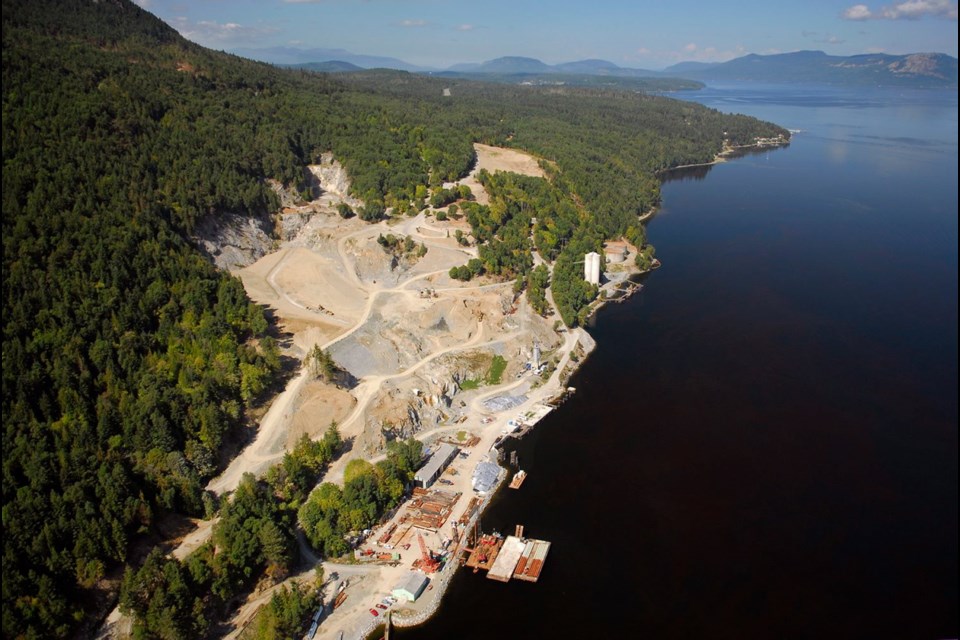The company proposing a floating liquefied natural gas plant at Bamberton has found a partner to build a 128-kilometre natural gas pipeline to fuel it.
Steelhead LNG, which is working with the Malahat First Nation, has partnered with U.S. pipeline developer Williams to design the pipeline. It will seek regulatory approval for what is being called the Island Gas Connector Project.
Steelhead intends to use the pipeline to fuel both the Malahat project and a proposed Sarita LNG facility near Port Alberni.
An additional pipeline would be required to deliver natural gas to the Sarita facility.
While he noted the announcement is a step forward, Steelhead chief executive Nigel Kuzemko stressed the work is at the earliest of stages and it would be speculation to put a dollar figure on either the pipeline or the LNG facility at Bamberton.
“We’ve got a lot of work to do to understand the environmental impact of the pipeline,” he said in an interview. “We have to design it. The route will vary depending on what is going on on the sea floor. Once we have designed it we can cost it, the same goes for the [LNG facility].”
Kuzemko said announcements are being made now to engage the community.
“We go [public] as soon as possible, there is no blueprint of this project already done, we are at the very beginning here,” he said. “We haven’t put a project description into government to start an [environmental assessment] process yet because we want to engage strongly with the community and First Nations first.”
Though a route has not been mapped, the pipeline would run from Williams’ interconnect with Spectra Energy’s B.C. pipeline system at Sumas, Washington, to Cherry Point, Washington.
From there, it would travel 75.2 kilometres under water, landing at the Malahat project on the Saanich Inlet.
Given the early stage of the Malahat proposal, provincial politicians have held off on offering opinions about the project. But NDP natural gas critic Bruce Ralston said, like all LNG projects, it faces a challenging process to get approval.
“It’s such a challenging location … and they couldn’t do it without public support and I just don’t see there ever being public support for a LNG facility in that location, I just can’t see it,” he said. “[A pipeline partner] is a small step toward completion of the project, but they are a long, long, long way away.”
A Ministry of Natural Gas Development statement noted the proposals are in their early stages. “The projects they propose, including the pipeline, are subject to rigorous environmental reviews and technical assessments. Steelhead LNG will also need to complete engagement activities with First Nations, local communities and stakeholders.”
Kuzemko said that process, which will include consultation with First Nations, landowners and communities in both Canada and the U.S., is underway. “And we will have open houses in the local community as soon as we can now that [the pipeline announcement has been made],” he said.
The pipeline is subject to the approval of the Federal Energy Regulatory Commission in the U.S. and the National Energy Board in Canada.
Steelhead and the Malahat First Nation have said they are prepared for plenty of protests from a community that has repeatedly fought against development at Bamberton.
The Malahat LNG plant would be able to produce six million tonnes of LNG annually and result in 200 long-term jobs on top of hundreds of jobs created during construction, Steelhead has said.
During the announcement of the Malahat project, Kuzemko said the company was not deterred by the cancellation of the Strait of Georgia crossing pipeline in 2004.
At that time, despite spending $50 million over four years, B.C. Hydro scrapped a $340-million pipeline that was to fuel gas-fired electricity generation on Vancouver Island. That plan was killed because it was deemed too expensive and didn’t fit the Island’s energy needs.
Kuzemko said technology improvements and a change in the demand for natural gas energy makes this project viable now.



